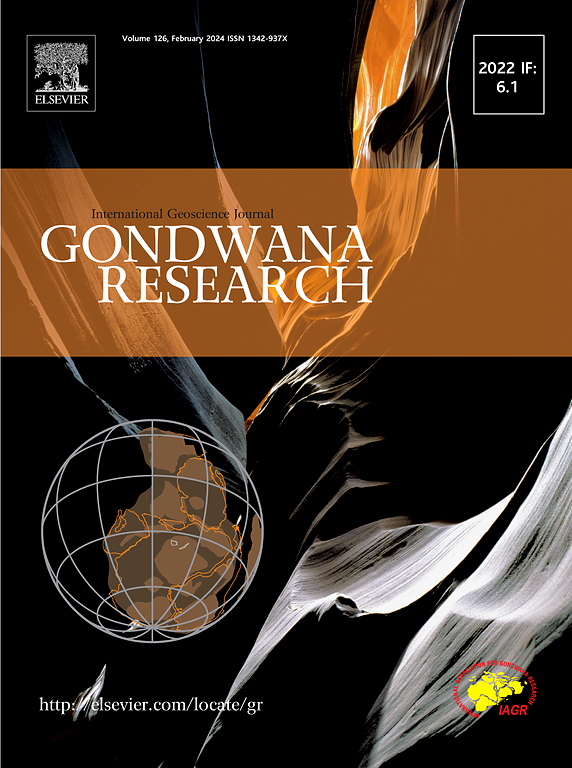西藏西北石泉河蛇绿岩上侏罗统放射虫组合和燧石地球化学:对中特提斯海洋演化的启示
IF 7.2
1区 地球科学
Q1 GEOSCIENCES, MULTIDISCIPLINARY
引用次数: 0
摘要
中特提斯海洋(MTO)的演化是一个有争议的问题。西藏班公-怒江缝合带蛇绿岩对解释该洋的演化具有重要意义。在石泉河-纳木哥蛇绿岩带(SNMZ)西部的石泉河蛇绿岩层状燧石岩中发现了保存完好的上侏罗统(铁拉统)放射虫组合。它们包括51属83种,代表了该缝合带蛇绿岩中有记录的最多样化的放射虫动物群。结合放射性年龄,这些组合表明狮泉河蛇绿岩的年龄不小于晚梯统世。燧石的LaN/CeN和Ce/Ce*比值支持靠近大陆边缘的成熟大洋盆地的沉积。网络分析显示,放射虫动物群与整个特提斯王国的其他同时期组合相似。我们的研究表明,SNMZ蛇绿岩记录的海洋至少存在于晚侏罗世,并发展成为一个成熟的海洋盆地,与新特提斯海洋有海洋联系,而不是像以前推断的那样是一个短暂的胚胎海道。本文章由计算机程序翻译,如有差异,请以英文原文为准。

Upper Jurassic radiolarian assemblages and chert geochemistry of the Shiquanhe ophiolite, NW Tibet: Implications for the evolution of the Meso–Tethyan ocean
Evolution of the Meso-Tethyan Ocean (MTO) is a contentious issue. Ophiolites in the Bangong–Nujiang Suture Zone, Tibet, are important for deciphering the evolution of this ocean. Well-preserved Upper Jurassic (Tithonian) radiolarian assemblages have been recovered from bedded cherts in the Shiquanhe ophiolite in the western Shiquanhe–Namuco ophiolitic mélange zone (SNMZ). They include 83 species belonging to 51 genera, representing the most diverse radiolarian fauna yet documented in ophiolites along this suture zone. Together with radiometric ages, these assemblages indicate that the Shiquanhe ophiolite is no younger than late Tithonian. LaN/CeN and Ce/Ce* ratios of cherts are supportive of deposition in a mature oceanic basin close to a continental margin. Network analysis reveals that the radiolarian fauna is similar to other coeval assemblages across the entire Tethyan realm. Our study suggests that the ocean recorded by the ophiolite of the SNMZ existed from at least the Late Jurassic and developed into a mature oceanic basin with a marine connection to the Neo-Tethyan Ocean, rather than as a short-lived embryonic seaway as previously inferred.
求助全文
通过发布文献求助,成功后即可免费获取论文全文。
去求助
来源期刊

Gondwana Research
地学-地球科学综合
CiteScore
12.90
自引率
6.60%
发文量
298
审稿时长
65 days
期刊介绍:
Gondwana Research (GR) is an International Journal aimed to promote high quality research publications on all topics related to solid Earth, particularly with reference to the origin and evolution of continents, continental assemblies and their resources. GR is an "all earth science" journal with no restrictions on geological time, terrane or theme and covers a wide spectrum of topics in geosciences such as geology, geomorphology, palaeontology, structure, petrology, geochemistry, stable isotopes, geochronology, economic geology, exploration geology, engineering geology, geophysics, and environmental geology among other themes, and provides an appropriate forum to integrate studies from different disciplines and different terrains. In addition to regular articles and thematic issues, the journal invites high profile state-of-the-art reviews on thrust area topics for its column, ''GR FOCUS''. Focus articles include short biographies and photographs of the authors. Short articles (within ten printed pages) for rapid publication reporting important discoveries or innovative models of global interest will be considered under the category ''GR LETTERS''.
 求助内容:
求助内容: 应助结果提醒方式:
应助结果提醒方式:


